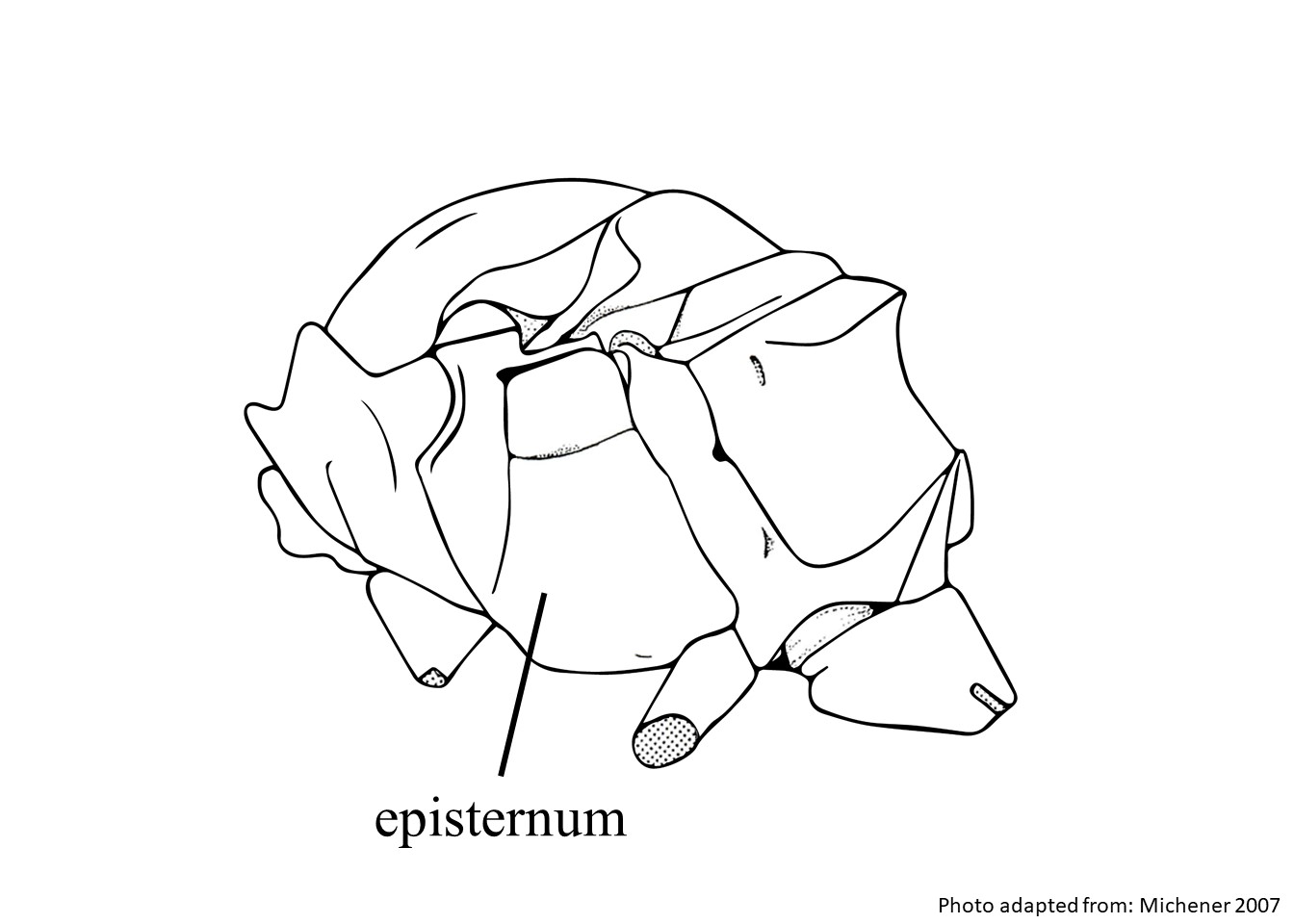Family: Megachilidae
Subfamily: Megachilinae
Tribe: Osmiini
Genus: Osmia Panzer, 1806
Subgenus: O. (Osmia) Panzer, 1806
Species: Osmia kohlii Ducke, 1899
Common name: none
Osmia kohlii are black bees with vibrant red hair on tergaterga:
the segments on the top side of the abdomen, often abbreviated when referring to a specific segment to T1, T2, T3, T4, T5, T6, or T7 (Peters 1978Peters 1978:
(Peters 1978Peters 1978:
Peters, D.S. 1978. Systematik und Zoogeographie der west-palauml;arktischen Arten von Osmia Panzer, 1806 s. str., Monosmia Tkalcu, 1974 und Orientosmia n. subgen. (Insecta: Hymenoptera: Megachilidae). Senckenbergiana Biologica (Frankfurt) 58: 287ndash;346.). Females have black hair on their head and thorax, contrasting with the bright hair on their abdomen (Peters 1978Peters 1978:
Peters, D.S. 1978. Systematik und Zoogeographie der west-palauml;arktischen Arten von Osmia Panzer, 1806 s. str., Monosmia Tkalcu, 1974 und Orientosmia n. subgen. (Insecta: Hymenoptera: Megachilidae). Senckenbergiana Biologica (Frankfurt) 58: 287ndash;346.). Males have intermixed white and black hair on their head, light hair on the scutumscutum:
the large segment on top of the thorax located between the wings and behind the head
, and black hair on the episternumepisternum:
the lateral or side areas of the thorax, excluding the lateral surfaces of the propodeum
 (Peters 1978Peters 1978:
(Peters 1978Peters 1978:
Peters, D.S. 1978. Systematik und Zoogeographie der west-palauml;arktischen Arten von Osmia Panzer, 1806 s. str., Monosmia Tkalcu, 1974 und Orientosmia n. subgen. (Insecta: Hymenoptera: Megachilidae). Senckenbergiana Biologica (Frankfurt) 58: 287ndash;346.). Female body length is 14–15 mm, and male body length is 12–16 mm (Ducke 1900Ducke 1900:
Ducke, A. 1900. Die Bienengattung Osmia Panz. Ber. naturw.-med. Ver. Innsbruck 25: 1ndash;323.).
(modified from Peters 1978Peters 1978:
Peters, D.S. 1978. Systematik und Zoogeographie der west-palauml;arktischen Arten von Osmia Panzer, 1806 s. str., Monosmia Tkalcu, 1974 und Orientosmia n. subgen. (Insecta: Hymenoptera: Megachilidae). Senckenbergiana Biologica (Frankfurt) 58: 287ndash;346.)
 without apicalapical:
without apicalapical: with hair entirely red (or yellowish in old specimens) with no dark hairs intermixed.
with hair entirely red (or yellowish in old specimens) with no dark hairs intermixed. with a clear gradulusgradulus:
with a clear gradulusgradulus:Osmia kohlii may be confused with O. cornuta and O. tricornis (Peters 1978Peters 1978:
Peters, D.S. 1978. Systematik und Zoogeographie der west-palauml;arktischen Arten von Osmia Panzer, 1806 s. str., Monosmia Tkalcu, 1974 und Orientosmia n. subgen. (Insecta: Hymenoptera: Megachilidae). Senckenbergiana Biologica (Frankfurt) 58: 287ndash;346.). Female O. kohlii can easily be distinguished by the shape and puncturing of the clypeusclypeus:
a section of the face below the antennae, demarcated by the epistomal sutures as well as the combination of entirely dark hairs on the head and thorax and entirely red hair on the abdomen. Male O. kohlii can be differentiated from O. cornuta by the shape of the middle femurfemur:
the third segment of the leg, situated between the trochanter and the tibia
, which is not expanded in O. kohlii. The males of O. tricornis can be separated by the episternumepisternum:
the lateral or side areas of the thorax, excluding the lateral surfaces of the propodeum
 which is primarily light-haired, in comparison to O. kohlii which is mostly dark-haired.
which is primarily light-haired, in comparison to O. kohlii which is mostly dark-haired.
Osmia kohlii adults have been recorded in flight from the end of March to the beginning of June (Peters 1978Peters 1978:
Peters, D.S. 1978. Systematik und Zoogeographie der west-palauml;arktischen Arten von Osmia Panzer, 1806 s. str., Monosmia Tkalcu, 1974 und Orientosmia n. subgen. (Insecta: Hymenoptera: Megachilidae). Senckenbergiana Biologica (Frankfurt) 58: 287ndash;346.).
Osmia kohlii are generalists associated with flowers from 11 different families. Popaver, Ranunculus, and Cistaceae are important pollen hosts (Haider et al. 2013Haider et al. 2013:
Haider, M. S. Dorn, C. Sedivy, A. Muuml;ller. 2013. Phylogeny and floral hosts of a predominantly pollen generalist group of mason bees (Megachilidae: Osmiini). Biological Journal of the Linnean Society 111: 78ndash;91.).
unknown
Osmia kohlii is native to the central Mediterranean region with specimens found in southern Italy, Sicily, Malta, and Corsica (Peters 1978Peters 1978:
Peters, D.S. 1978. Systematik und Zoogeographie der west-palauml;arktischen Arten von Osmia Panzer, 1806 s. str., Monosmia Tkalcu, 1974 und Orientosmia n. subgen. (Insecta: Hymenoptera: Megachilidae). Senckenbergiana Biologica (Frankfurt) 58: 287ndash;346.). Unclear but possible identifications have been made in North Africa (Alfken 1914Alfken 1914:
Alfken, J.D. 1914 Beitrag zur Kenntnis der Bienenfauna von Algerien. Meacute;moires de la Socieacute;teacute; Entomologique Belgique 22: 185ndash;237.).
Distribution map generated by Discover Life -- click on map for details, credits, and terms of use.